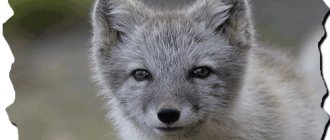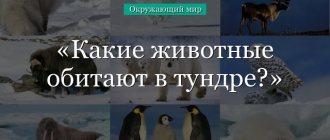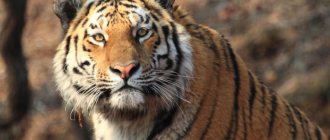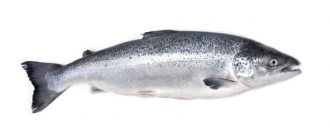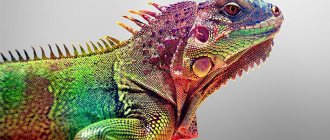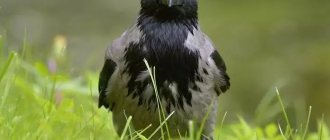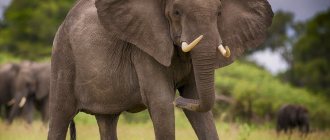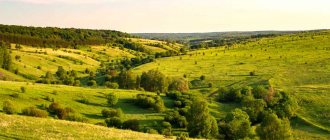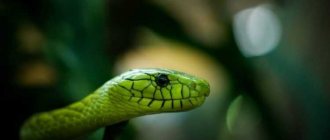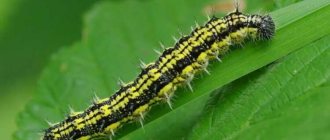Description
The mountain goat's body is of average size: length is about 120-180 cm, height at the withers is 80-100 cm, and weight is 40-155 kg, depending on the species and sex of the artiodactyl. Despite its strong torso and not very long legs, it gives the impression of a graceful animal. Males are decorated with large arched horns, some reaching 1 meter in length. The front surface of the horns has transverse thickenings, expressed to varying degrees in different types of goats.
As the name of the family suggests, mammals' horns are hollow inside. The hooves are very hard and narrow, thanks to which these animals easily and freely jump over rocky rocks, holding on to small ledges. The tail is quite short. They can be distinguished from rams by the presence of strong-smelling glands in the groin, around the eyes and on the legs, as well as by the presence of rough calluses on the knee joints of the front legs and the beard of males.
Mountain goats are gregarious mammals that form large herds of 20-30 individuals in the winter. In summer, males and females are divided into separate groups of 3-5 individuals. They feel comfortable high in the mountains, deftly jumping along small ledges over wide, several meters, cliffs. You can watch how a herd of mountain animals moves with amazing ease along the vertical surfaces of rocks, balancing like real acrobats. Despite everything, they are very careful and warn each other of danger with subtle bleats.
Diet[edit]
A young mountain goat licks a salt handrail
Mountain goats are herbivores and spend most of their time grazing. Their diet includes grasses, grasses, sedges, ferns, mosses, lichens, and twigs and leaves of low-growing shrubs and conifers of their high-altitude habitat.
Mountain goat grazing at Mount Rushmore, South Dakota
In captivity, the mountain goat's diet may also include grains, alfalfa, fruits, vegetables, and grass.
Status and commercial value of the Siberian mountain goat
As mentioned earlier, Siberian mountain goats make good contact with representatives of livestock; people use this to tame animals and selectively breed new subspecies. In addition, such unions produce rich offspring. In addition to attempts to tame mountain goats, they are placed in zoos. There are also attempts to increase the population, but the species are not mixed, trying to maintain their purity. In zoos, animals are cared for, well fed and treated for illnesses. In the wild, part of the population lives in protected areas, which also gives them protection and help from people, especially during the difficult winter months.
Free hunters, poachers, cause great harm by reducing the population for the sake of prey, meat, skins, and horns. Such hunting is prohibited and punishable by law.
History of appearance
The beginning of hunting these animals dates back to ancient times. The place where people first took these animals into their homes is considered to be the north of Iran. The horns of a large male were coveted trophies among tribal peoples in different parts of the world. Finding and trapping such an animal was not an easy task.
From these animals, people learned to peel off the skins from which they made shoes and clothes, and used them as material for homes. Mountain goat meat was especially prized and was considered a delicacy by ancient people. People also used fat in food. After extracting so many useful products from goats, ancient man domesticated wild goats along with dogs. That is why there are now so many different breeds of this magnificent animal in the world, for example, meat, dairy, intended for fluff, and others.
In the Middle Ages, their skins were used to make containers for food and wine. Wild goat milk is still valued for its nutritional properties.
In the modern world, mountain goats can be found high in mountain cliffs, or in large zoos. There they easily take root and reproduce brilliantly.
Since ancient times, it was believed that goats are symbols of dark, evil or devilish power. However, they are actually very intelligent creatures and are highly trainable. One of the constellations is named after Capricorn, named after these representatives of the animal kingdom. Their outlines can be found in the drawings of many peoples inhabiting Eurasia.
Reproduction and offspring
Rutting time falls at the end of autumn - November. It lasts no longer than 20 days. During this period, males who have reached 5 years old gather females in a group of up to 15 individuals. They guard them and drive them from place to place. In general, mountain goats can mate already in the second year of life, and females bear offspring already in the third. But young males are simply not allowed to mate by older competitors. They are stronger and bigger, which means they can simply drive away weaker contenders.
Pregnancy lasts up to 6 months, which means birth occurs in May - June. In the initial period, females still remain in the herd, but closer to childbirth they retire to ensure safety and peace for themselves and future offspring. They look for a suitable cave and stay there. In the wild, a female rarely gives birth to more than one kid; if this happens, one of the kids most likely dies due to weakness. At the zoo, the birth of two kids is not uncommon, as care and food are plentiful. Babies are born weighing from 3 to 5 kg. At first they are weak, lying helplessly on stones or branches. But within a few days they will be able to move among the stones on thin legs. The mother feeds the offspring with milk for a month, then the cubs completely switch to eating grass, foliage, flowers, quickly gaining weight. The horns begin to grow around this time.
Reproduction
The mountain goat is a polygamous animal . The animal gives birth to offspring once a year. The mating period falls in late autumn. At this time, sexually mature males join the herd of females. The young immediately give way to more assertive and stronger individuals. Brave battles for females begin. Adult goats enter into mating fights. It should be noted that each such fight takes place in accordance with its own strict rules, so in rare cases the animal is fatally injured. Before the battle, the opponents stand opposite each other. Rising on their hind legs, they lock horns. Mountain goats, unlike rams, do not butt into the unprotected part of the body and do not rush to catch up with the losing male.
The goat that wins the fight has the right to assemble a harem of several females. Mountain goats bear cubs for up to six months , so offspring are usually born with the onset of spring, when it is already warm. One or two kids are already timidly walking on the ground a few hours after birth. But the newly hatched offspring are vulnerable, so during the first weeks the kids hide in secluded places. The goat returns to feed them milk, after which they accompany her everywhere.
A month later, the kids begin to demonstrate excessive mobility and playfulness: they run and climb on their mother. The animal gains independence by the end of the first year of life. Puberty in goats occurs at two years, and in males a little later. Life expectancy in the wild is from 7 to 15 years.
Appearance
Nubian ibex are the smallest of all mountain goats. They have well-defined sexual dimorphism: females are on average three times smaller in size than males. The total body length for males is 125 cm, and for females 105 cm. The height at the shoulders is on average 75 cm for males and 65 cm for females. The average body weight of males is 62.5 kg, females - 26.5 kg.
The general coloration of Nubian ibex is yellowish-brown (matching the color of the environment), with black and white spots on the legs and a white belly. Color changes are possible starting in August, when in males it can vary from dark brown to black on the neck, chest, shoulders, belly and front of the thighs. Males have a dark stripe on their back. The horns are very long and thin, curved first back and then down. In males, the horns can reach one meter in length, in females - up to 30 cm.
Breeds Sulaiman and Sanada
The Sulaiman breed is considered quite famous. Goats of this variety differ in coat color. As a rule, they have a gray-red tint, and a brown stripe is visible on the back. Their lower limbs are mostly white, but dark brown markings are visible. By the way, in appearance, goats of the Sulaiman breed are very reminiscent of horned goats. This goat is also distinguished by the presence of some special characteristics of its horns. They are similar both to the horns of a marzur and to those of a bearded goat. They are slightly tipped back and the cross-section is flat. Today, the longest horns of representatives of this species are 74 cm long. But the record figure is 102 cm. This length of horns was registered in 1969.
In addition to the fact that the external similarity of the Sulaiman breed with the horned goat is noted, they also have similar habits. But there is a main difference, which is the mating time. In individuals of the Sulaiman breed, it begins only in the second half of October. As a result, their offspring can only be expected at the beginning of April. By the way, goats of this type often give birth to twins.
How humans use mountain goats
The blows of the horns are accompanied by a loud crack that can be heard a kilometer away, but they never cause injury to the fighting alpine goats.
All types of mountain goats easily interbreed with each other and give excellent offspring. This is how goats were domesticated and bred for meat, fluff, milk, and horns. All this is very valuable for a person: knitted items are warm, and milk is nutritious and healing. The leather industry widely uses the skin of these animals, from which high-quality products are obtained.
Wild alpine goat of the Nubian subspecies (Capra ibex nubiana) on the side of a highway in Egypt (Sinai Peninsula)
Wild goats are hunted for the same purposes
Horns have long been considered a mystical talisman, since rarely does anyone manage to get a cautious and timid goat.
Many mountain goats live in the zoo. They are easily tamed, reproduce well in captivity and are a decoration for any zoo.
Do you want to know how a hippopotamus differs from a hippopotamus? Then this is the place for you!
Breed varieties
Mountain goats are divided into three groups. The classification is based on the structure of the horns. In total there are 8-10 species of these beautiful animals. Mountain goat groups:
- Capricorns. Representatives (goats): Iberian, Nubian, Siberian, Ethiopian and Alpine (ibex). These are animals with wide (near the head) and gradually tapering arched large horns. Length - up to one meter (in males). Numerous transverse ridges are visible on the upper surface. The horns are curved back and slightly diverge to the sides. Animals of this group live in mountainous, steppe and hilly areas.
- Tours. Representatives: Western Caucasian, Eastern Caucasian, Severtsova. Turs have long horns that grow back or to the sides. They have an arcuate or semi-spiral shape. The surface of the horns is slightly ribbed. Turs live mainly in mountainous areas (in the Caucasus).
- Goats. Representatives: point-horned goat, domestic goat (more than 300 breeds). Unlike domestic animals, horned wild goats live in Asia, in the mountains. They have long, twisted horns that resemble a corkscrew. Female horned animals also have twisted horns, but small.
Behavior
Capra nubiana becomes active at dusk. During the day, he hides from predators and heat in secluded shady places located among inaccessible rocks. During particularly hot periods, the ungulate grazes under the cover of night.
In search of food, it descends from the tops of the mountains to the lower tiers, and after feeding it returns back. In relatively cool weather, feeding occurs before the onset of midday heat.
Nubian goats are extremely social and live in small groups. They have a strict social hierarchy. As a rule, they consist of females and their young. Old goats gravitate towards proud loneliness. Males older than three years old form bachelor communities, which include up to 8 individuals.
The main natural enemies are leopards (Panthera pardus), wolves (Canis lupus) and striped hyenas (Hyaena hyaena). The juveniles are hunted by birds of prey, most often golden eagles (Aquila chrysaetos) and common eagle owls (Bubo bubo).
General features of structure and behavior
In the anatomy and behavior of all mountain goats, common features can be traced, due to which they were combined into one group. First of all, you can indicate the place of residence - hills and various mountain ranges. Only one species lives on the plains, but this is not their personal choice, but human intervention - the domestic goat lives where we want it. Other wild animals choose rocky ledges, where they easily hide from predators.
Characteristic anatomical features:
- the horns are massive, straight or saber-shaped (twisted in aurochs), much larger in males than in goats;
- the eyes are large with a rectangular pupil;
- ears are large and mobile;
- long hair on the beard, lower neck and chest of goats;
- glands that secrete an odorous secretion (especially during the breeding period), at the root of the tail, in the groin;
- the tail is small, triangular.
Mountain goats are medium-sized animals with a muscular build. The weight of adult males varies from 70 to 150 kg, and females - 50-90 kg. Females are always much smaller than goats; goats’ heads are also decorated with small horns, and there is usually no beard. The color of the coat of these animals is integumentary and depends on the characteristics of the area where they live - snowy mountains, rocky ones. Twice a year, goats change their coat; in winter, longer hair grows and down appears.
For most of the year, all types of goats live at higher elevations - in the belt from 500 to 3500 meters.
Rarely do animals rise higher in search of food or to escape predators. In lowland areas, goats can be found in the summer when there is abundant grass or during severe cold weather; some species take shelter from frost.
The ranges of different species of mountain goats usually do not overlap. These animals do not form large groups, but live in small herds of 3-10 individuals, which are headed by females. The breeders stay alone or in small groups most of the year, and join the goats during the mating season. The start time and duration of the rut have specific characteristics; they differ especially greatly among neighboring species, which allows goats to avoid unnecessary skirmishes and mixing of blood. Goats spend most of the day searching for food. Mountain vegetation is sparse and low in nutritional value, so the body of all species has adapted to eating the worst food: dry leaves, various branches, thorns. In the summer, goats switch to green food and actively gain fat on nutritious grass. In winter, activity can be observed at all times of the day, and in summer during cool hours.
Mountain goats are hunted by many predators: wolves, snow leopards, and golden eagles. But the main danger for all species is humans . Poachers destroy huge numbers of these animals for trophies. Indirectly affects goats and agriculture - in regions with traditional sheep and goat breeding, mountain pastures are used for grazing domestic animals, which forces wild species to move to the highlands and remote areas, which reduces the range and reduces the food supply.
In many countries, mountain goats are taken under state protection. Nature reserves and national parks are opening, where they are trying to control the shooting of animals and feed them during harsh periods. But the programs being developed to protect and restore mountain animal species are not working well so far and the animals remain in danger of extinction.
2.2.Generalizations of the fuzzy c-means algorithm
In the basic fuzzy c-means algorithm, the distance between an object and the cluster center is calculated through the standard Euclidean norm: . In cluster analysis, other norms are also used, among which the diagonal norm and the Mahalonobis norm are often used.
In general, the norm can be specified through a symmetric positive definite matrix B of size as follows:
,
where T is the transposition operation.
For the Euclidean norm, the matrix B is the identity matrix:
.
The Euclidean norm makes it possible to distinguish clusters in the form of hyperspheres. For the diagonal norm, the matrix B is given as follows:
.
The elements of the main diagonal of the matrix are interpreted as coordinate weights. The diagonal norm makes it possible to identify clusters in the form of hyperellipsoids oriented along the coordinate axes.
For the Mahalonobis norm, matrix B is calculated through the covariance matrix of:
,
where is the covariance matrix;
— vector of average data values.
The Mahalanobis norm makes it possible to distinguish clusters in the form of hyperellipsoids, the axes of which can be oriented in arbitrary directions.
Examples of isolines of various norms are shown in Fig. 2.1. In Fig. 2.2 shows an example of fuzzy clustering using the fuzzy c-means method with Euclidean distance. The left side of the figure shows the data for clustering. The right side of the figure shows the results of fuzzy clustering. The centers of fuzzy clusters are indicated by '+' symbols. Eight isolines of fuzzy cluster membership functions were constructed for values of 0.67, 0.71, 0.75, 0.79, 0.83, 0.87, 0.91 and 0.95.
Figure 2.1 - Isolines of various norms
Figure 2.2 - Fuzzy clustering with the Euclidean norm
For some data sets, “eye clustering” allows you to identify clusters of data in the form of various geometric shapes: spheres, ellipsoids of different orientations, chains, etc. As a result of clustering algorithms with a fixed norm, the shape of all clusters is the same. Clustering algorithms seem to impose on the data a structure that is not inherent to them, which leads not only to suboptimal, but sometimes to fundamentally incorrect results. To eliminate this shortcoming, several methods have been proposed, among which we highlight the Gustafson-Kessel algorithm.
History of the Alpine ibex
Currently, there are about 30-40 thousand of these animals in the Alps. And at the beginning of the nineteenth century, Alpine goats were almost on the verge of destruction. The whole point is that medieval people considered capricorns to be mystical and sacred creatures. Their fur, bones and blood were sometimes credited with the most extraordinary properties, including the ability to heal ailments. All this led to a zealous hunt for the animals.
By 1816, there were no more than a hundred Alpine goats left. They were miraculously preserved. All the Alpine goats that exist today descended from that hundred. Subsequently, the animals were taken under protection, due to which their numbers gradually increased.
Horned goat
This is one of the most spectacular species of wild artiodactyls. The horned mountain goat, whose name was given for its uniquely shaped horns, also has another name - markhor. Translated from Urdu, it means "snake-eating".
A large mammal, depending on age, can weigh up to 90 kilograms and reach more than one and a half meters at the withers! Despite its impressive size, the marking goat maneuvers with extraordinary ease on steep cliffs in search of food.
The powerful horns of males, similar to the screw of a corkscrew, endow the animal with amazing dignity, stature and grace. Naturally, they are the main decoration of the markhor. If the length of the horns of old males is 1.5 meters, then the horns of females are small and neat, growing only up to 30 centimeters. The animal's hair is short throughout the body, except for a spectacular long beard and shaggy chest.
Young individuals are gray-red, and with age the color changes to off-white. Horned goats live high in the mountains, constantly traveling along the rocks in search of sparse but useful vegetation. Habitat: mountain ranges of the Himalayas, Tibet, Kashmir, Pakistan and Tajikistan. This species of mountain goat is considered endangered and is therefore protected by the International Union for Conservation of Nature. The population remains in some of the world's largest reserves.
Range and habitat[edit]
The mountain goat is native to the Rocky Mountains and Cascade Range, as well as other mountainous regions of the Western Cordillera of North America, from Washington, Idaho, and Montana through British Columbia and Alberta to the southern Yukon and southeastern Alaska. Its northernmost range is believed to be on the northern edge of the Chugach Mountains in south-central Alaska. Introduced populations can also be found in areas such as Idaho, Wyoming, Utah, Nevada, Oregon, Colorado, South Dakota, and the Olympic Peninsula of Washington.
Mountain goats are the largest mammals found in high-altitude habitats, which can reach elevations exceeding 13,000 feet (4,000 m). They sometimes descend to sea level in coastal areas, although they are mainly alpine and subalpine species. The animals generally remain above the tree line throughout the year, but migrate seasonally to higher or lower elevations within this range. Winter migrations to low-lying mineral licks often carry them several kilometers through forested areas. [8]
Appearance
This is one of the largest representatives of the genus of mountain goats, and according to some data, the largest. The body length of males is 130-160 cm, height at the withers is 80-110 cm. Weight, according to some sources, is over 60 kg, and in the fall up to 90 kg, according to others it reaches 130 kg.
The most authoritative Soviet sources of the 1960-1970s indicated the number of Siberian goats throughout the USSR at 500 thousand heads; At the same time, it was emphasized that due to a sharp drop in the number of the species, hunting for it was then prohibited.
The Siberian mountain goat is a fairly large ungulate. Outwardly, it somewhat resembles a domestic goat, but is more muscular, lean and slender. The relatively short, powerful body rests on strong, thick legs with blunt hooves. The head is relatively large, with a cone-shaped muzzle, and the neck is muscular. In males, the horns reach a huge size; they are arched backwards, bearing frequently located and strongly convex transverse ridges. The horns reach a length of 150 cm; in females they are much smaller, up to 40 cm.
Sexual dimorphism is expressed, as in general in all species of the genus Capra, quite strongly. Females are much smaller than males, their horns are also much less developed, and their beards are much smaller.
The color of summer fur is brownish, while the underparts are lighter. Old males are often dark in color, almost chocolate brown. Females and young animals are even brownish or brown in color. In winter, the color is yellowish-gray or brownish-gray. The beard, which reaches significant development in males, is black-brown in summer and brown-brown in winter. A dark-colored black-brown stripe stretches from the back of the head along the back to the base of the tail. The belly is covered with long hair with a brownish color.
The tracks of this goat, according to zoologists, can be easily confused with the tracks of other ungulates; in any case, until very recently its traces remained little studied.
The Siberian goat is a silent animal. He rarely gives voice outside the mating season. In case of alarm, it can emit a sharp whistle; a wounded or caught goat moos dully. Young ones can make sounds similar to the bleating of a domestic lamb, but more dull. During the rut, males roar loudly, females also roar, but much quieter.
Interesting facts about the Alpine ibex
- The horns of a male Alpine mountain goat reach about 1 m in length.
- This species, like other goats, is characterized by a special, pronounced “goat smell”. Animals may spray themselves with urine.
- In Medieval times, people used all parts of the body, as well as the blood, fur and feces of ibex, as medicinal products. Because of this, the animals were actively hunted and the population was almost completely exterminated until the beginning of the 19th century, after which the species was taken under protection and restored.
What does the Siberian mountain goat eat?
Siberian stone goats feed on grass. At different times of the year, the menu consists of different products. In summer and autumn the diet is richest. In summer these are herbs, leaves from bushes, young shoots, flowers. In the fall, these are still herbs, but seeds of cereal plants are added, rarely, but you can come across berries of rose hips, currants, and rowan. With pleasure, goats eat the branches of these bushes and willows, gnaw the young bark, and pluck green leaves. They go out to pastures early in the morning and in the evening, when the heat subsides. During the warm season, body weight can increase up to 20-30 kilograms.
In winter everything is much worse, there is little food, the slopes are covered with snow. The animals go down, closer to the forest-steppe, where they tear the snow with their hooves in search of dry grass, lichens, and look for moss on the trees. In winter, feeding does not stop throughout the daylight hours, since it is impossible to find enough food at a time. Finding salt licks to replenish the body’s supply of salt and minerals is also not easy. You have to travel up to 20 kilometers in search of ponds and streams, rocks whose banks are covered with salty deposits.
What do they eat?
Mountain goats feed on everything they find in the mountains: grasses, branches of bushes, mosses, lichens. They taste everything they see and then decide whether they will eat it or not. Wild animals eat bark, leaves, fruits. If desired, they can climb a tree. They love salt very much, for which they even climb the walls of a concrete dam. Animals graze early in the morning or late in the evening. At lunchtime they rest or hide in the shade from the sultry sun. In places where predators can lie in wait for them, they go out to pasture only at night, and during the day they hide in rocks.
Iberian ibex
The Pyrenean (Iberian) ibex is difficult to confuse with other subspecies of wild mountain goats, since they have a unique coloring. The thick short hair on the bridge of the nose and forehead, belly and legs is colored black, and the neck, chest and back are light brown. The horns are spread out to the sides, but thinner than those of other ibex, and the weight does not exceed 80 kilograms. Habitat: mountain ranges on the Iberian Peninsula, located in southwestern Europe.
So, mountain goats are bright representatives of artiodactyls of the bovid family with characteristic features and behavioral features. Unfortunately, it is not only human hunting that poses a threat to them: these herbivores are the main prey for many predators - lynxes, snow leopards, wolves and even golden eagles. In North Africa, they form the basis of the diet of leopards.
Another problem for mountain goats is avalanches and periods of hunger, when it is difficult for animals to find food. Only thanks to the surprisingly high fertility of goats, the number of populations in nature is quickly restored. However, some rare species are listed in the Red Book and are protected by the International Conservation Community.
Conservation of mountain wild goats
Alpine goats are very popular as hunting objects due to their good fur and tasty meat. Animal horns are of particular value as a beautiful hunting trophy. Due to human economic activity, deterioration of the ecological state of the environment, as well as hunting, some breeds of wild goats are listed in the Red Book. Extinction threatens: marking goats, Iberian ibex, West Caucasian and East Caucasian aurochs. Wild alpine goats occupy a special ecological niche, so the extinction of this animal species will be a difficult loss for the natural environment.
Video
How Siberian goats adapted to life on the rocks
When at rest, goats move slowly. They may not trot clumsily, but if a mountain goat runs on a flat surface, a dog will easily catch up with it. These animals are saved thanks to their incredible ability to move along rocky slopes. At the slightest danger, goats rush onto the rocks, making powerful jumps.
Mountain goats are capable of not only flying up slopes with lightning speed, but their jumps down are also amazing.
Walking on rocky embankments is very dangerous and difficult, since the stones go out from under your feet and roll down, so the whole area can crumble, but Siberian mountain goats jump along them very confidently and easily. If stones begin to fall, the goats slow down or stop completely.
Coat color varies depending on the region and time of year.
In a calm environment, Siberian mountain goats, as a rule, follow a chain one after another, but if the animals are frightened, they scatter in all directions and often overtake the leader. If necessary, these goats can swim quite well, they are even able to overcome fairly wide rivers.
Interesting Facts
The Siberian mountain goat attracts attention not only with its powerful appearance, but also with interesting facts:
- In winter, animals stay closer to the warm southern slopes, where there is dried grass. To find it under the snow, they tear it apart with their forelimbs.
- The animal is considered sedentary, but small seasonal movements are allowed.
- Both females and males have horns. However, in males they are much more massive and longer. In addition, they are strongly curved back.
- Adult males have special folds near the tail in which an odorous secretion is produced, and its production occurs during the “mating season.”
The Siberian mountain goat tries to stay away from people. However, if he notices a person, he does not immediately try to run away. Initially, he will take a closer look at him and observe his actions, being at a decent distance from him. In case of danger, it will quickly and gracefully begin to climb up the rocks.
Range and habitats
The habitat of the Siberian mountain goat is not large. It is distributed in the territories of Russia, Kazakhstan, Afghanistan, China, Tajikistan, Kyrgyzstan, Uzbekistan, India, Pakistan. They do not overlap with other subspecies. They choose gorges and mountain slopes to live, rarely going out to plains and open areas, although this does happen. If the animals are not disturbed by people, they can descend into the lowlands, to heights of up to 1500 meters above sea level, but usually stay higher, sometimes climbing up to 5500 meters, which is very high. There is an opinion that at altitude goats feel physically lighter, the air there is thinner and the atmospheric pressure suits them. The movements also coincide with the time of year. In winter, individuals move down to make it easier to find food and survive frosts.
Ungulates live in small groups, up to 10 individuals. Typically, males stay separate from young and females. They unite only during the rut, when the herd numbers about a hundred heads. Rocks, with their crevices and caves, give animals safety, sheltering and hiding them from predators.
Interesting! Young males often leave their group, traveling tens of kilometers away from their relatives. Observations of mountain goats have shown that this behavior is determined by the hierarchy and role of these individuals. Up to a certain age, they act as scouts, checking the area for dangers and looking for places rich in food.
Classification and evolution[edit]
The mountain goat is an ungulate of the order Artiodactyla and the family Bovidae, which includes antelopes, gazelles and cattle. It belongs to the subfamily Caprinae, along with true goats, wild sheep, chamois, muskox and other species. The takins of this Himalayan region, while not sister to the mountain goat's lineage, are nevertheless very closely related and almost coeval with the mountain goat; they developed in parallel from the ancestral goat. Other members of this group are pseudo-
"blue sheep", true goats and Himalayan tahr.
The sheep line is also very close, and the musk ox line is somewhat more distant. Mountain goats probably diverged from their relatives at the end of Torton, approximately 7.5-8 million years ago. [ citation needed
]
Given that all major lineages of goats emerged in the late Miocene and contain at least one, but usually several species from the eastern Himalayas, their most likely place of origin is between or near today's Tibet and Mongolia. Thus, the ancestors of the mountain goat likely crossed the Bering Strait after diverging from their relatives, presumably before the Wisconsinian glaciation. No Pliocene mountain goats have yet been identified; the known fossil record is very recent, entirely from North America, and hardly distinguishable from living animals. In the Pleistocene, a small prehistoric mountain goat, Orymnos harringtoni
lived in the southern Rocky Mountains. Ancient DNA studies suggest that it was a sister species of the living mountain goat, not its ancestor; therefore, living species also date back to the Pleistocene. [2] [3]
The mountain goat is the only living species of the genus Oreamnos
.
The name Oremnos
comes from the Greek word
oros
ore
stalk ) "mountain" (or alternatively
oreas
"mountain nymph") and the word
amnos
"lamb".
Behavior
Ibex female
A typical Ibex herd consists of 10-20 females and cubs. In addition to them, there are less stable herds of young bachelors, as well as mature males living alone. During the mating season, which in the Alps lasts from December to January, males visit herds and try to gain control over them. Fights often occur between rival goats. To have a chance to win such a fight and have his own herd, the male must be at least six years old. Throughout the winter, the male remains in the herd and leaves it in the spring.
After a pregnancy lasting from five to six months, the female gives birth to one, sometimes two, cubs in May or June. The cub is able to stand on its feet from the first day, but remains with its mother and feeds on milk for about another year. The lifespan of an Ibex can reach 20 years.
Arabian tahr
The Arabian tahr lives in only one region on earth - the Hajar mountainous area on the Arabian Peninsula, which is partly located in Oman and partly in the UAE. Animals live in mountains and rocks in an extremely dry climate.
The Arabian tar has a dense build and strong legs, suitable for climbing steep rocks. The animal is completely covered with long red-brown hair, and a dark stripe stretches along the back. Females and males have long, curved back horns.
Mystery of nature
Many people wonder how such large mammals manage to stay on steep rocks? It's all about strong, small hooves. The hard hoof horn allows you to stand in a very small area without experiencing discomfort.
A tiny ledge on the rock will be enough for the animals not only to maintain their balance, but also to be able to run along steep slopes. The hooves are equipped with ultra-sensitive pads that provide additional traction on rocky surfaces. In addition to their hooves, goats are helped to stay on steep rocks by:
- exceptional sense of balance;
- filigree coordination of movements;
- acute vision, allowing you to notice even small stone protrusions.
If, having stood on a stone, the animal realizes that it is too small and it will not be possible to stay on it, it instantly finds the next ledge, to which it quickly jumps.
Himalayan tahr
The Himalayan tahr is a goat, sometimes also called the goat antelope. The animal looks really very similar to a goat, but at the same time it has long brown-red hair and reaches a height of one meter. Tars, as a rule, try to stay in small family groups. Sometimes they unite in herds, the number of which reaches 30-40 individuals. Tahrs are very careful and at the slightest danger they run over stones through forests, easily avoiding steep slopes. During the mating season, the animals fight with each other with their horns, fighting for the female.
Reproduction of Siberian mountain goats
Under favorable living conditions, sexual maturity in males and females occurs in the 2nd year. But most often, female goats have their first kids at the age of 3 years. And males take part in reproduction even later - at 4-5 years old, since before that they are driven away by stronger individuals, but if mating does occur, it is accidental.
Siberian goats are polygamous animals. Strong males create harems of several females. Together with the offspring, such families consist of 10-16 individuals. The rut occurs at different times: in the Pamirs, the mating season occurs in December-January, and in Altai – in November. During the rutting period, males are very excited, so at the end of the rut they noticeably lose weight.
Fierce fights occur between males. It doesn’t often lead to serious injuries and death, but sometimes you can find two corpses of goats locked horns on the river bank. Young individuals are driven away by stronger rivals, and they wander behind the herd in order, if possible, to cover a female who has lagged behind the harem.
Siberian mountain goats live at altitudes of up to 6700 m.
In females, pregnancy lasts about 5-6 months. Females leave the herd for a while to bathe. They give birth in secluded gorges. Most often, one kid is born, and rarely, twins.
Two babies are mainly born to adult females in zoos, as good nutrition is provided there. Newborn kids weigh 2.8-4.8 kilograms. The baby is able to stand on fragile legs already on the first day of life, and can even walk a little. But mostly for the first few days he is too weak, so he lies in the bushes or between the stones. After a few days, he is not only able to follow the female, but also skillfully jump over stones. Young goats run better and faster than older goats.
The babies' horns begin to grow almost immediately; they are already good by 3-4 weeks. At one year of age, they grow up to 10-12 centimeters in length; in winter, the horns grow more slowly, and sometimes their growth stops completely.
Kids begin to pinch greens at 3-4 weeks of life, and after a month they practically switch to grassy food. In a year, a kid weighs approximately 2/3 of the weight of an adult. Siberian horned goats grow for a long time - up to about 9 years.
Potential dangers for Siberian mountain goats include uncontrolled hunting and poaching.
In nature, Siberian mountain goats rarely live more than 10 years, but in London in the Zoological Garden one female lived to be 22 years old, and she did not die a natural death, but was killed.
Lifestyle
The inhabitants of the rocks eat plant foods. Grass, shrubs, and tree bark are used. An important element of the diet is salt. Animals lick it off ledges in salt marshes. Bucks and female goats live in herds of 20-30 individuals, but some species prefer a solitary existence, for example, representatives of ibex. In the summer, the herds climb the mountains to a height of up to 4 thousand meters. In winter, to escape frost and cold winds, they descend lower.
The mating season begins in the spring. At this time, battles take place between males for the right to own “beautiful ladies.” The tournament participants clash horns and try to knock each other down. The winning goat covers the females.
Gestation takes 5-6 months. Newborn goats quickly stand on their feet and are ready to follow their mother along the rocks. Goats live up to 10 years in the wild. In zoos the period increases to 15.
Goats living high in the mountains are amazing animals. Any climber will envy their ability to climb rocks. Unfortunately, all species suffer from the desire of greedy people to get their skins or beautiful horns, as a result of which some of them are on the verge of extinction.
Description
The group called “goats” has two types -
- horned goat (markhora),
- domesticated mountain goat (subspecies - bezoar goat, its ancestor).
Also, in turn, markhor has three subspecies, which differ from each other only in small features of the structure of the horns and habitat.
It lives in the mountains of Tajikistan, Little Tibet, Western Himalayas, Kashmir and Afghanistan. It is characterized by:
- helical horns (to which he owes the name of his species), which reach 0.5 - 1 m in length,
- a long black-brown beard (dewlap), which, as it becomes lighter, becomes a hanging mane.
- head and legs are dark in color,
- belly is light in color,
- body length – up to 1.5 -1.7 meters,
- tail length – up to 17-18 cm,
- height – no more than 90 cm,
- weight – no more than 90 kg,
- reddish-gray coat color, becoming dirty white over time.
The domestic goat usually has laterally compressed horns that form a sharp leading edge.
The protruding rib of the horn is not as clearly defined as in other groups, while some individuals may have no horns at all. It is impossible to establish other general characteristics, since there are a large number of breeds of domesticated goats that differ in coat color, size, etc.
The most recognizable, as a rule, is the bezoar goat, which lives in Afghanistan, the Caucasus, Balochistan, Persia and Asia Minor and on some Mediterranean islands. It is characterized by the following symptoms:
- strongly curved horns with converging tips that are arched back,
- physique – stocky, legs – strong, with wide hooves,
- the coat is long, its color in males, like in many others, depends on the season: in winter it has a silvery-white body, the chest and part of the muzzle are black-brown, in summer it takes on a reddish tint, in females it has yellowish-brown fur,
- characteristic two stripes: one along the back, the second from the chest to the back, in females there is one such stripe,
- tail – black, approximately 12 cm,
- body length - about 1.5 m, occasionally there are individuals 1.2 -1.6 m,
- weight depends on gender and age and ranges from 25 kg to 95,
- height – 0.7-1 m.
Despite its rather extensive habitat, the bezoar goat is also listed in the Red Book.
Varieties
Mountain goat species are most often classified according to the already mentioned scheme, in which they are divided into three classes and eight species. The main differences between species are the shape of the horns and, to a lesser extent, size and slight differences in body structure and coloration. A description of the habits for each species is unnecessary, since they are practically the same, varying slightly depending on the geographical location.
Capricorns
A very interesting class of mountain goats. Representatives of this class are very easy to distinguish by their characteristic horns, curved like scimitars. In cross section they represent a triangle. In general, outwardly, capricorns are very similar to aurochs, although there are differences between them. In terms of habitat, ibex species vary greatly and, geographically, cover a considerable area.
Nubian
This species of ibex is considered the most beautiful among its relatives. At the same time, it is inferior to all of them in terms of mass.
The coat color is sandy with brown and black markings. The Nubian ibex has white knees. The beard is very thick and eye-catching. These beauties live in Africa and the Arabian Peninsula.
Ibex
An extremely rare representative of the mountain goats, living in the mountains of Piedmont and Savoy. The weight of an adult male reaches 100 kg. Females are much smaller - only 40 kg maximum. Moreover, a tenth of the total weight of males falls on their luxurious and long horns. The latter can weigh 10-15 kg and reach up to 1 m in length.
The fur color of males and females also varies. The former have a dark brown color, while the latter sport a reddish-golden hue. True, this difference is typical only for warm periods. In winter, both are covered with thick, inconspicuous gray fur.
Siberian
One of the few representatives of mountain goats in general and ibex in particular, which has so far avoided the threat of extinction. Whether this is due to the harsh climate of its habitat, its relatively unprepossessing appearance, or its natural vitality and intelligence is difficult to say. One way or another, Siberian ibex are quite numerous, and, by the way, they live not only in Siberia and Altai, but also in Afghanistan and India.
When the plainness of Siberian ibex was mentioned, this in no way referred to their main advantage - their horns. The latter can exceed a meter in length, and at the same time they are always strongly bent back. The texture of the horns is not original, but the impressive size makes an impression.
Perinean
A distinctive feature of this species is its coat color. The neck and back are light beige, while the forehead and nose, belly and legs are dark tar. The size of Perinean ibex, compared to their counterparts, is small. The maximum weight in adult males is about 80 kg. Their horns are also somewhat thinner and shorter than those of other subspecies, but they have a beautiful lyre-shaped shape. They live on the Iberian Islands and the highlands of Spain.
Tours
Living mainly in the Caucasus, aurochs are quite similar to ibex, but are larger in size. And their horns, in general, diverge more strongly to the sides, although in other respects they are very similar to those of capricorns. All types of tours are on the verge of extinction and are listed in the Red Book.
Caucasian mountain tour
This species of mountain goats lives on the mountain ranges of the Caucasus. He has short red hair, very massive horns, diverging in different directions and curved in the manner of sabers, almost like those of capricorns. The peculiar patterns created by the ribbing of the horns only emphasize the beauty of the animal. An adult male can reach a mass of 100 kg and a height of 1 m and 10 cm. Females are much less impressive in size, like other species. Today, the West Caucasian mountain goat is represented by a population of approximately 10,000 individuals worldwide.
East Caucasian (Dagestan) tour
This type of tour cannot be confused with any other. Even in the photo. And there is only one reason for this - the unique shape of the horns. First, they are bent almost in a spiral, like those of rams. And secondly, the angle between the horns is almost 180 degrees (or 0, as you prefer). Simply put, they are directed in diametrically opposite directions. This feature allows them to be easily distinguished from other relatives of the East Caucasian aurochs.
Severtsov's tour
Very similar to its Western Caucasian counterpart. This is especially true for the shape and structure of the horns, which are almost identical. The differences lie in the smaller size of the animal itself and its main weapon, as well as a different color. The fur of Severtsov's tur is light beige in color, and is very hard and thick.
Horned goats
This variety of mountain goats is represented by only one species. However, this selection was not made in vain. The fact is that markhor (another name for the horned goat) has a unique shape of horns. He has them screwed in like a corkscrew and stretched along his body. That’s why this species is called “spinhorns”. The length of these “corkscrews” can reach one and a half meters. The maximum growth of these animals is exactly the same.
Another distinctive feature of markhor is its coat. It is inconspicuous in color: from light, almost white, to dark gray. However, the beard and chest of the animal are covered with long hair, about 30 cm long, while the back part is covered with short hair.
Of course, due to such a unique shape of the horns, there are many hunters for such a souvenir. And, unfortunately, these are hunters in the literal sense of the word. Therefore, the marking goat is classified as a protected species.
Dangers and Enemies
The main enemies are those predators that are able to climb to great heights and survive in the conditions there. These are the leopard, the snow wolf, and among the birds - the golden eagle. The first ones feel free on the mountain slopes. Their tactics are to set up ambushes and rush at the goats with huge leaps from behind the stones. But they can catch up with prey in a swift dash on the plain. Wolves more often attack older individuals who have lost their former agility and are unable to quickly climb over rocks to higher ground. Golden eagles mainly attack young people who have not become strong and have not gained much weight.
Interesting! In winter, it is not only retreating scouts who warn the herd of danger. Goats don't have to rely only on their senses. Snowcocks, birds from the pheasant family, settle next to the horned birds in winter. These birds warn neighbors about danger before they notice it.
In addition to predators, animal populations may suffer losses due to natural phenomena such as rockfalls and avalanches. Also, during severe winters, when everything is covered with snow and ice, it is impossible to get food, which leads to the death of the entire herd. Considerable damage to the population is caused by people, or rather by poachers who shoot artiodactyls for trophies.
In the wild, individuals live no longer than 15 years; in zoos they can live up to 20 years.
Western Caucasian or Kuban tour
These animals are very graceful. The West Caucasian Tur lives on the border of Georgia and Russia. Its habitat is not very large and is only a narrow strip with an area of about 4,500 square kilometers, which is constantly shrinking due to human activity.
The Kuban tur is considered by the International Union for Conservation of Nature as a species that is in great danger. Currently, there are no more than 10,000 individuals worldwide. In the wild, the West Caucasian tur often meets with the East Caucasian tur, as a result of which hybrid individuals are born that are not capable of producing offspring. This is also one of the reasons for the decrease in livestock.
Kuban aurochs are genetically close to bezoar goats, and their external similarity with Dagestan aurochs can be explained by hybridization, which is confirmed by the latest scientific research.
Features of behavior in natural conditions
If Siberian goats are hunted in their habitats, they become very shy and cautious. However, if there is no danger from a person and he does not hunt them, these goats can allow people to get quite close to them, and sometimes even begin to graze with domestic animals.
If one of them smells something that looks like a dangerous object, he can, without looking up. monitor the potential source of threat for about half an hour.
In normal circumstances, sounds from these animals are heard extremely rarely. Most often this is a whistle, which means a signal of a potential threat. But during the rutting season, the males roar deafeningly. The sounds that females and small kids sometimes make are very similar to the bleating of domestic goats, except that the timbre is more dull.
Description of chamois
Another variety of wild goat is the chamois. It is also called Rupikapra. Chamois belongs to the bovid family and the goat subfamily. She is often hunted. These animals prefer to live in Europe and Asia Minor. As a rule, they can be found in the Alps, Balkan Mountains, and Carpathians.
These mountain animals are very nimble. In the summer they prefer to be on the rocks, but in the winter they go down to the meadows and forests. They hide in thickets where no one can pass. The animal is capable of rising in height by 2.5-3 km and descending in convenient places by 1 km. They prefer to avoid mountains with permanent glaciers and snow. Chamois are very attached to a specific area. They can be found every day at the same time in a certain area. If livestock grazing begins in this place or a person hunts, then the chamois simply changes the time of its stay in this area from day to night, so as not to catch guests. Sexual maturity of an individual occurs at approximately 2-3 years. The offspring appear in the first weeks of summer. In a year you can get no more than 3 babies from a female.
Description of the Siberian mountain goat
Some scientific sources claim that this species is the largest among the goat family. Males are larger than their female companions. Males grow more than a meter in height - 110 cm, their body length reaches 1.5 - 1.7 meters. Females grow up to 80 cm and length up to 1.3 – 1.5 meters. They weigh no more than 90 kilograms. The weight of males reaches an impressive figure of 130 - 150 kilograms, but this does not prevent them from deftly and skillfully maneuvering among the rocks.
Interesting! Several other signs besides size will help to distinguish individuals by gender. The male sex wears large, beautiful horns, while the female sex is limited to thin, short horns. Males have long goatees; females do not have them, but have long, thick hair on the neck and chest. In adult females, the abdomen is more convex, which is a consequence of pregnancy and the birth process. They have clearly visible mammary glands for feeding.
The body is muscular, lean, slender. The legs are not long, but quite thick. They end in thin, flat hooves. The hooves are hard, the toes on them are inactive. The body is straight, there is no arch in the back or noticeable hump, and the croup is not drooped. The tail is short, about 6 cm, with a bald patch at the end. The neck is entwined with muscles, but not thick, extended upward. The head is large, pointed towards the nose. The ears are long relative to the head - 10 cm, mobile and sensitive, catching the small rustle of stones. The eyes sit wide, on the sides of the head. The iris is black or dark brown. The tip of the nose is black and not covered with hair. The upper coat is forked and slightly reveals the upper incisors. But the most noticeable detail that catches your eye is the horns. Different species of mountain goats can have horns of all sorts of bizarre shapes - twisted in a spiral, curled back, growing straight up, even twisted like a ram's. Siberian mountain goats have horns that grow straight up and back, and curl down at the ends. Males wear truly huge processes on their heads, which often exceed the size of the head itself, growing more than 120 cm. Females wear more modest horns no more than 35 cm long. The surface of the bone processes is ribbed and resembles a wave.
The entire scalp consists of coarse hair. They are thicker in winter and short in summer. Some areas of the body are covered more densely, for example, the chest, front of the neck, stomach. Males have a long beard and are black and brown in color. Individuals change color twice a year, when they grow overgrown before winter and molt in spring. The summer color scheme has more brown and brown colors, with light accents on the legs, stomach, and chest. The winter outfit is duller, the brown color dilutes the grown gray hair. With age, the color of males darkens; older individuals are covered with monotonous dark chocolate fur. A black stripe running from the head across the entire back stands out against the general background. All individuals have it.
Movement of the Siberian mountain goat
Due to the peculiarity of the structure of the hooves, their narrow, elongated shape, Siberian goats cannot walk in deep snow. They have to choose areas with the least snow cover. The dimensions of the body and the length of the legs do not allow for fast running, and the rough terrain does not contribute to this. But they can make springy jumps of 3 meters and climb very well, even on sheer rocks, with the least amount of small ledges. This is how horned animals escape from danger, not by running away, but by climbing to heights.
Voice
Despite the fact that Siberian mountain goats are related to rams and gorals, the sounds they make when communicating are definitely akin to those of goats. This is typical of the "meeee" family. The frequency and duration vary, sometimes the sound is prolonged, sometimes short, but always quiet. Animals prefer not to make noise, often replacing “meee” with a quiet moo or even a whistle. They raise their voices during the rut, then males and females roar loudly.
List of sources
- ami.nstu.ru
- www.syl.ru
- wiki2.org
- animals-mf.ru
- zooclub.org.ua
- wiki.bio
- madhunter.ru
- animalreader.ru
- GoFerma.ru
Alpine goats
Alpine ibex are members of the genus of mountain goats that can only be seen in the Alps. They live at altitudes of up to 3.5 thousand meters and love to surprise tourists with their ability to climb steep cliffs. Animals feel great in the mountains, on the border between forest and ice. In winter, in search of food, goats are forced to go a little lower, but they rarely do this, since alpine meadows are dangerous for them in terms of predators. But Capricorns also show unprecedented caution. When going to a watering hole or just to pasture, they always leave a guard goat, which can warn others about the danger in time.
Alpine goats are quite large animals, the weight of which can reach one hundred kilograms and a height of one and a half meters. Females, naturally, are much more modest in size, their weight hardly reaches forty kilograms. Like their Siberian relatives, they boast impressive horns. In males they can reach one meter, but in females this part is slightly smaller.
Animal horns are not just decoration, but very serious weapons. Between November and January is the mating season. At this time, single males begin to look for a suitable herd of females, driving away all their rivals. Often they have to participate in real serious battles, in which powerful horns are the main weapon. Having won a herd of goats, the animal remains in it for some time, and in the spring each female gives birth to one or two kids. Over the next year, they feed their offspring with milk.
Subsequently, the older generation behaves in the same way as other wild goats, the species of which are given in the article: females do not leave their herd, but mature males will have to leave. At the beginning of independent life, males try to create their own herds, but, as a rule, they disintegrate quite quickly.
